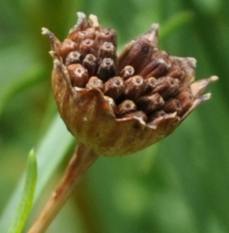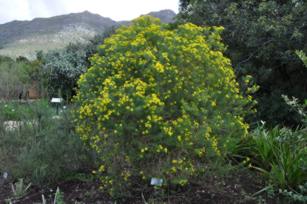Euryops linearis
Euryops linearis Harv.
Family: Asteraceae
Common names: De Hoop euryops (Eng.)
Introduction
Euryops linearis is a showy, easy-to-grow, tall shrub, covered with bright yellow daisies in spring.

Description
Description
An upright, slender, much-branched shrub 0.5 to 3 m tall, with a rounded habit. The branches are densely leafy in the upper parts, becoming leafless lower down. The leaves are spreading (i.e. they extend outwards horizontally) and linear (i.e. elongated, slender and the margins are parallel or nearly so), 10-40 mm long and 10-25 mm wide, and taper to the base. They are also flat and thin, and dark green.
The flowerheads are daisy-like with yellow ray petals and yellow centres . They are produced on short flower stalks in clusters of up to 12 flowers, at the tips of the branches. The flowerheads are showy and cover the bush during late winter and spring (August-October).
The fruit is a narrowly oblong, hairless, light brown cypsela (a dry, one-seeded fruit like a sunflower `seed'), faintly or indistinctly ribbed, 2.5-3.5 mm long and 0.8-1 mm wide.

Conservation Status
Status
Euryops linearis is Rare and Vulnerable, meaning that it has a small wild population and distribution range, and faces a high risk of extinction in the wild. The number of wild plants is declining because their habitat is being destroyed by invasive alien acacias. Pollution is also damaging their habitat.
Distribution and habitat
Distribution description
Euryops linearis is endemic to the area between Bredasdorp and De Hoop in the vicinity of the Potberg, in the Western Cape, where it is known from only eight locations. It is found on limestone hills and ridges and coastal dunes, usually partly shaded. It is also occasionally found among sandstone rocks on the Potberg.
Derivation of name and historical aspects
History
Euryops is derived from the Greek eurys meaning large or wide and ops meaning eye or face, referring to the large, showy flowerheads of the typical species. This species is named for its linear leaves, from the Latin linea, a string or line.
The genus Euryops consists of 97 species, mainly in Africa, with one species extending into the Arabian Peninsula and Socotra. There are 89 species in southern Africa where they are widespread. Many Euryops species make very decorative garden subjects and the following are also grown at Kirstenbosch: E. abrotanifolius, E. chrysanthemoides, E. pectinatus, E. virgineus, E. tysonii, E. annae, and E. speciosissimus.
Ecology
Ecology
Like many species from the De Hoop and Agulhas area, Euryops linearis is tolerant of limestone soils, while most fynbos plants are not. But this does not mean that it needs alkaline soils in order to survive. Under cultivation it will grow equally well in sandstone- or granite-derived acidic soils.
Uses
Use
There are no recorded uses of Euryops linearis. However, many Euryops species are known as harpuisbos, meaning resin bush, because they secrete resin from the stem and branches, some producing more than others. It sometimes appears as blobs on the stems and twigs and collects under the bushes. In the past, this resin was greatly valued by both the Khoisan and the colonists for its alleged medicinal properties. It was also used as a substitute gum, and to preserve leather, like boots and saddles.

Growing Euryops linearis
Grow
Euryops linearis makes a very desirable tall garden shrub. It is quick and easy to grow, water-wise, and has finely textured, dark green foliage and bright yellow flowerheads in winter-spring. It needs well-drained soil and a sunny or partly shaded situation. It will thrive in both alkaline and acidic soils, and is a useful plant for lovers of fynbos who have neutral to alkaline soils and struggle to grow fynbos that needs acidic soils.
It can be planted in the shrubbery, as a backdrop, informal hedge or for screening. It can be planted in a water-wise garden, does well in the fynbos garden, strandveld garden, Cape Flats garden and is equally at home in the average suburban garden. Prune to keep tidy and bushy, or replace after a few years if they start to look a bit sparse and lax. Planting in groups of three to five results in a larger, denser bush.
Euryops linearis is easy to propagate from seed or cuttings. Seed is ripe quite soon after flowering (November), and drops to the ground. Sow seed in spring to early summer or in late summer to autumn in a well-drained medium, keep moist, and warm but not hot, and pot up when the seedlings are large enough to handle. Seedlings also come up around the plants in the garden and are easily transplanted. Take tip or heel cuttings in spring or early summer, treat with a rooting hormone and place in a mist unit with bottom heating. The cuttings root easily in about 3 weeks.
References
- Leistner, O.A. (ed.). 2000. Seed plants of southern Africa: families and genera. Strelitzia 10. National Botanical Institute, Pretoria.
- Mustart, P., Cowling, R. & Albertyn, J. 1997. Southern Overberg. South African Wild Flower Guide 8. Botanical Society of South Africa, Cape Town.
- Nordenstam, B. 1968. The genus Euryops . Part 1: Taxonomy. Opera Botanica 20 .
- Plants of southern Africa: an online checklist. http://posa.sanbi.org
- Raimondo, D., Von Staden, L., Victor, J.E., Helme, N.A., Turner, R.C., Kamundi, D.A. & Manyama, P.A. (eds) 2009. Red List of South African plants 2009. Strelitzia 25. South African National Biodiversity Institute, Pretoria.
Credits
Alice Notten
Kirstenbosch National Botanical Garden
December 2012
Plant Attributes:
Plant Type: Shrub
SA Distribution: Western Cape
Soil type: Sandy, Loam
Flowering season: Spring, Winter
PH: Acid, Alkaline, Neutral
Flower colour: Yellow
Aspect: Full Sun, Morning Sun (Semi Shade), Afternoon Sun (Semi Shade)
Gardening skill: Easy
Special Features:
Horticultural zones










Rate this article
Article well written and informative
Rate this plant
Is this an interesting plant?
Login to add your Comment
Back to topNot registered yet? Click here to register.